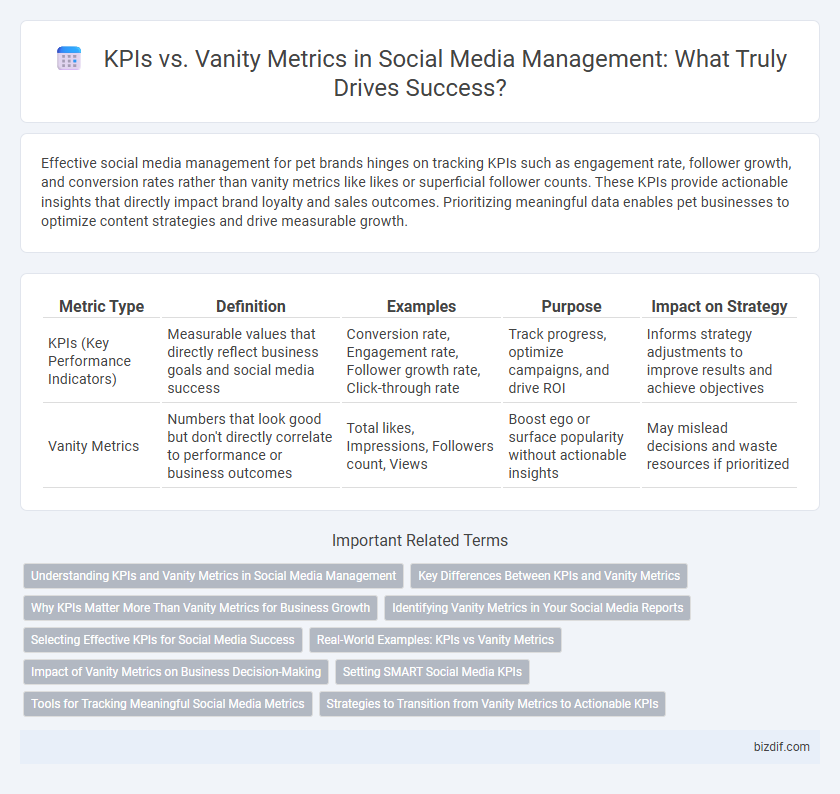Effective social media management for pet brands hinges on tracking KPIs such as engagement rate, follower growth, and conversion rates rather than vanity metrics like likes or superficial follower counts. These KPIs provide actionable insights that directly impact brand loyalty and sales outcomes. Prioritizing meaningful data enables pet businesses to optimize content strategies and drive measurable growth.
Table of Comparison
| Metric Type | Definition | Examples | Purpose | Impact on Strategy |
|---|---|---|---|---|
| KPIs (Key Performance Indicators) | Measurable values that directly reflect business goals and social media success | Conversion rate, Engagement rate, Follower growth rate, Click-through rate | Track progress, optimize campaigns, and drive ROI | Informs strategy adjustments to improve results and achieve objectives |
| Vanity Metrics | Numbers that look good but don't directly correlate to performance or business outcomes | Total likes, Impressions, Followers count, Views | Boost ego or surface popularity without actionable insights | May mislead decisions and waste resources if prioritized |
Understanding KPIs and Vanity Metrics in Social Media Management
Key Performance Indicators (KPIs) in social media management provide measurable and actionable data that directly relate to business goals, such as conversion rates, engagement rates, and follower growth. Vanity metrics like likes and shares offer surface-level insights but lack the strategic value needed to evaluate campaign effectiveness or ROI. Prioritizing KPIs over vanity metrics enables data-driven decisions that optimize social media strategies for sustained growth and audience impact.
Key Differences Between KPIs and Vanity Metrics
KPIs in social media management directly measure performance outcomes such as engagement rate, conversion rate, and follower growth, reflecting the success of strategic goals. Vanity metrics like total likes or follower count often inflate perceived popularity without indicating real business impact or audience quality. Understanding the distinction ensures resource allocation targets meaningful data that drives growth rather than superficial numbers.
Why KPIs Matter More Than Vanity Metrics for Business Growth
KPIs such as engagement rate, customer acquisition cost, and conversion rate directly measure the effectiveness of social media strategies in driving business growth, unlike vanity metrics like follower counts or likes that offer superficial insight. Prioritizing KPIs enables businesses to make data-driven decisions, optimize campaigns for better return on investment, and align social media efforts with overall marketing objectives. Focusing on actionable KPIs improves resource allocation and ensures social media activities contribute to sustainable revenue generation and customer retention.
Identifying Vanity Metrics in Your Social Media Reports
Identifying vanity metrics in your social media reports involves distinguishing superficial numbers like follower counts or likes from actionable KPIs such as engagement rate, conversion rate, and click-through rate. True KPIs provide insights into how well content drives business goals, whereas vanity metrics often inflate performance without indicating real progress. Prioritizing metrics linked to audience interaction and lead generation ensures effective social media management and decision-making.
Selecting Effective KPIs for Social Media Success
Selecting effective KPIs for social media success requires focusing on measurable metrics that directly impact business goals, such as engagement rate, conversion rate, and follower growth. Unlike vanity metrics like likes or superficial follower counts, true KPIs provide actionable insights into audience behavior and campaign performance. Prioritizing data-driven KPIs enables optimized content strategies and improved ROI from social media efforts.
Real-World Examples: KPIs vs Vanity Metrics
Real-world examples highlight the critical difference between KPIs and vanity metrics in social media management, such as tracking conversion rates, click-through rates, and customer acquisition cost versus focusing on likes, comments, and follower counts. Brands like Nike measure engagement quality through purchase behavior and lifetime customer value, whereas vanity metrics can mislead by inflating perceived success without driving business goals. Effective social media strategies prioritize actionable KPIs that directly influence revenue and customer retention over superficial popularity indicators.
Impact of Vanity Metrics on Business Decision-Making
Vanity metrics such as likes and follower counts often create a misleading perception of social media success, diverting attention from key performance indicators (KPIs) like conversion rates and engagement quality. Businesses relying heavily on vanity metrics may make misguided decisions that do not contribute to revenue growth or customer loyalty. Focusing on KPIs enables data-driven strategies that improve marketing ROI and long-term brand value.
Setting SMART Social Media KPIs
Effective social media management requires setting SMART KPIs--Specific, Measurable, Achievable, Relevant, and Time-bound--to track real performance and drive strategic outcomes. Unlike vanity metrics such as likes and followers that offer surface-level engagement insights, SMART KPIs focus on conversion rate, click-through rate, and audience retention to measure campaign success accurately. Prioritizing these actionable KPIs ensures continuous optimization and meaningful growth aligned with business objectives.
Tools for Tracking Meaningful Social Media Metrics
Effective social media management requires tools that distinguish KPIs from vanity metrics by tracking engagement rate, conversion metrics, and audience growth. Platforms like Sprout Social, Hootsuite Analytics, and Google Analytics provide comprehensive dashboards for measuring meaningful performance indicators that directly impact business goals. Utilizing these tools helps marketers focus on actionable insights rather than superficial likes or follower counts.
Strategies to Transition from Vanity Metrics to Actionable KPIs
Shifting focus from vanity metrics like follower counts and likes to actionable KPIs involves identifying measurable goals aligned with business outcomes such as conversion rates, engagement quality, and customer retention. Implementing social media analytics tools enables tracking of these KPIs in real time, providing insights into content performance and audience behavior. Strategy includes setting clear objectives, regular performance reviews, and adjusting campaigns based on data-driven findings to maximize ROI in social media management.
KPIs vs vanity metrics Infographic

 bizdif.com
bizdif.com